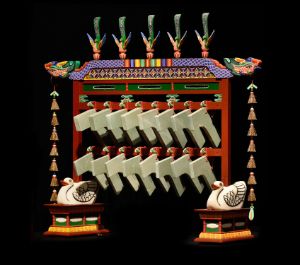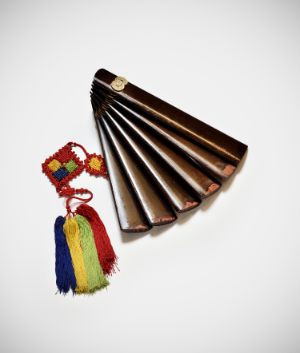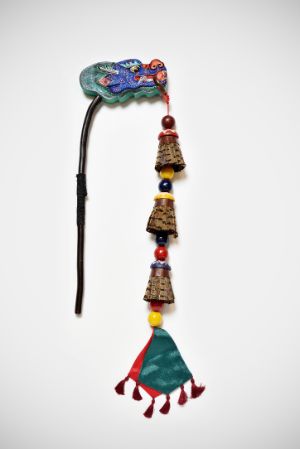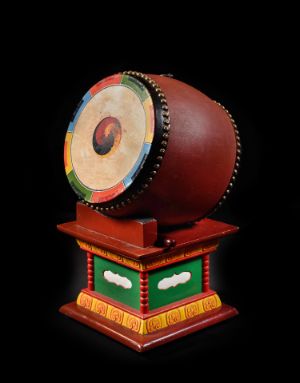
Columns in front of Basilica di San Marco, Venice, and Jongmyo Shrine, Seoul
© agefotostock / Richard Ellis / Alamy Stock Foto
Resonating Bridges
Sacred Music of Europe and Asia and their Roots in Ritual
The question of which music from bygone eras we know and perform today is significantly decided by how it is handed down. In the field of European art music, the melodies of Gregorian chant are among the earliest works that we can reconstruct thanks to preserved records. Across the centuries, these religious chants have given us an idea of how people make music in praise of god. The same goes for an ancestral ceremony from Korea. The instruments of Jongmyo Jeryeak may be unfamiliar and the aesthetic premises may differ from those of Western music. But as an invocation of the ancestors, Jongmyo Jeryeak too represents a musical tradition cultivated for centuries and used to allow humans to get in touch with the transcendent.
1
GREGORIAN CHANT AND VESPRO DELLA BEATA VERGINE
Songs of Faith
In the Beginning is the Word
The word of the Holy Script is so existential to Christians, that they place it at the centre of their prayers several times a day. And it makes no difference whether they are Roman or Orthodox or (later) Protestant Christians. The Gregorian Chant emerged in the 8th century; it was named after Pope Gregory (590 – 640), one of the great theological authorities of late Antiquity. The chants had Latin texts and were sung monophonically and without any musical accompaniment – to this day, they are a highly fascinating archaic sound experience.
The Gregorian Chant in the Musikfest Berlin 2022 Programme
In no other epoch of western music has the text entered into an equally close connection with the melodies as in Gregorian Chant. The days were structured by prayers sung communally: “Ora et labora” – “pray and work” was the motto of the Benedictine order. Over the course of 24 hours, the monks gathered seven times to sing psalms and hymns set to Gregorian music. They had to know all the chants by heart because at that time, there were hardly any books in the libraries of the monasteries where they could have been put into writing. The Gregorian Chants were of existential importance for the monks: They learned them by heart in order to feed on them for the rest of their lives. And so they became ingrained in them.
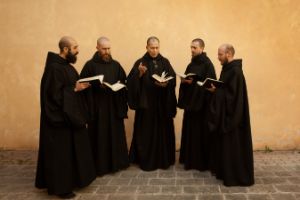
Singing Monks from the Monastery San Benedetto in Norcia, Italy
© Christopher McLallen
Hildegard von Bingen
Hildegard von Bingen was born in 1098. Intended by her family for a monastic career at an early age, she entered the Benedictine Order in 1112. At the age of 43, she began writing her first texts. After founding her own monastery in 1150/1151, these grew into a rich life’s work that made Hildegard von Bingen the most important writer and composer of her time. She was concerned with medicine, theology, philosophy, natural history and music; her holistic medicine is still known and used today in wellness treatments and fasting cures.
Hildegard von Bingen describes her writing as being based on divine inspirations, which she put down on parchment. However, her 77 hymns, written between 1151 and 1158, and her spiritual singspiel “Ordo Virtutum” show a great knowledge of the musical practice and works of her time. The musicologist Marianne Richter-Pfau describes the composer’s work as being based on traditional Gregorian chant on the one hand, but also connected to new musical forms of her time on the other. This gave rise to a very individual, unmistakable musical language.
Hildegard von Bingen’s works and writings were already intensively received by her contemporaries. She died in 1179 in her Rupertsberg monastery as a widely recognised universal scholar.
Sources br-klassik and InternationaleGesellschaft Hildegard von Bingen
Even centuries later, melodies were created in the same spirit: The first ever named female composer, the Benedictine nun Hildegard von Bingen (1098 – 1179), for instance, wrote chants to her own spiritual texts. Their virtuosity and expressiveness make these works into musical bridges into the late Middle Ages and the early Modern Age.
“While listening to a song, people sometimes breathe deeply and sigh. This reminds the prophet of the fact that the soul originates in divine harmony. Thinking about this, he realises that the soul itself carries something of this music and he invites it to: Give thanks to the Lord with the lyre; make melody to him with the harp of ten strings.”
Hildegard von Bingen
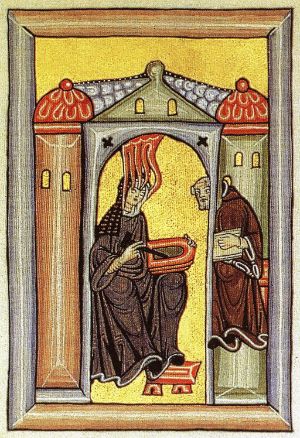
The seer Hildegardis, bathed in divine inspiration while writing, accompanied by the monk Volkmar
© Wiesbaden Codex, University and State Library RheinMain, image via Wikimedia Commons
Fluid Traditions
Barbora Kabátková in Conversation
Daniel Frosch: For many centuries, the Gregorian chant has provided a store of melodies that composers have used freely. In his “Vespro della Beata Vergine” (printed in 1610), even Claudio Monteverdi draws on it. There are several places in the work where the chants can be heard and others where they could be inserted. At Musikfest Berlin, you will be performing the “Vespro” – on the one hand as a singer and on the other as the director of choral singing. What was Monteverdi trying to show with this reference to the Gregorian chant, which was already very old during his time?
Barbora Kabátková: That is not entirely unambiguous. Gregorian chant is not necessarily music from a past age, because it has its own story. During the concert, we will be performing chants from the time around 1600, which are significantly different from the Gregorian chant as it was sung in the 9th century, for example. But of course there are quite different, innovative examples in the “Vespro”, such as the beginning, where Monteverdi quotes the opening of his opera “L’Orfeo” and has the wind instruments play their motifs over very simple harmonies. Or the way he stays very true to the text in the psalms of the vesper: It is really as if we were preparing for prayer.
DF: In your concert, you will be singing antiphonies between the vesper psalms, based on Gregorian singing. Opinions are divided on whether this is in accordance with the liturgical tradition or whether the concerti passed down by Monteverdi were intended to replace the antiphonies.
BK: It is still not clear whether the concerti were used instead of antiphonies. I don’t think that this was the case; for me, the concerti are a kind of interlude. In medieval times, there was the tradition of the cantio, simple songs with newly written music. They were intended to make the listeners think once more about the text that they had just heard. The cantio, which emerged during the 14th century, would then be an example for a new form of singing in the liturgy and could be compared with the concerti during Monteverdi’s time.
DF: Which Gregorian chants did you assemble?
BK: I looked for a suitable antiphony dedicated to the Virgin Mary for each psalm. It was not easy to find antiphonies in the right key, because many modes were unusual for this subject. Furthermore, there was a great deal of change following the Council of Trent that had to be considered. Luckily, I made a number of finds in Italian hymnbooks from the early 17th century and now I feel that the arrangement is coherent.
DF: While Philippe Herreweghe will conduct the performance, the responsibility for the antiphonies is in your hands – literally …
BK: Yes, it is a great honour for me to be allowed to lead these songs. Originally, I was only going to handle the preparations and hand over to Philippe. But he decided to leave the direction to me because I regularly perform music of this kind and it requires a form of conducting that is very different from leading a modern orchestra or a choir. Collegium Vocale Gent has a very good schola of male voices and I am very much looking forward to the privilege of performing these songs, which I usually present with the women of my Tiburtina Ensemble, with a male ensemble.
Claudio Monteverdi’s “Vespro della Beata Vergine” in the Musikfest Berlin 2022 Programme
A Musical “Portfolio”
The “Vespro della Beata Vergine” by Claudio Monteverdi (1567 – 1643) was published in 1610. The composer was not happy in his position at the Mantuan court and so he was looking for work in the field of sacred music elsewhere. Neither a specific commission nor any proof of a first liturgical performance exist in the case of the “Vespro della Beata Vergine”. It is not unlikely that Monteverdi used this composition to apply for positions away from Mantua. With a length of around 90 minutes, the piece is a major representative synopsis of its creator’s compositional accomplishments.
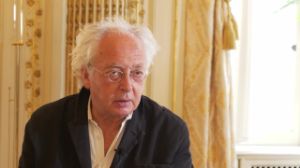
Philippe Herreweghe in conversation with Franziska von Busse about old and new elements in the Marian Vespers
Claudio Monteverdi
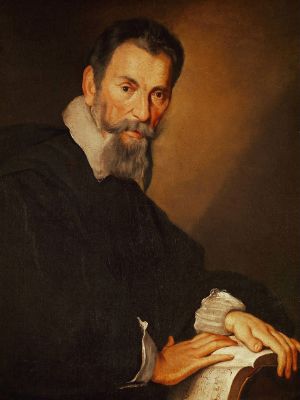
Claudio Monteverdi, portrait by Bernardo Strozzi, ca. 1630
© Tiroler Landesmuseum Ferdinandeum, Wikimedia Commons
Claudio Monteverdi (1567 – 1643) is one of the great revolutionaries in the history of music. With his work, which is deeply rooted in tradition but open to all that is new, he stands like no other for the upheavals at the threshold of the epoch in 1600. Although Monteverdi was a universal musician, his name is associated for us above all with two genres, the opera and the madrigal. With some justification, the premiere of Monteverdi’s “L’Orfeo” on 24 February 1607 at the court of Mantua can be regarded as the true birth of opera, because it took his creative power and dramatic instinct to turn the approaches of his predecessors, some ten years older, into a viable art form. Conversely, in the field of madrigal, Monteverdi brought an immensely rich and ramified genre to a conclusion with his work. Both genres are combined in one of his most expressive compositions, the “Lamento d'Arianna”, which was already famous during his lifetime and originates from a lost opera, but has survived in several madrigal arrangements in his own hand.
Monteverdi, who was baptised on 15 May 1567, grew up in the sheltered circumstances of a well-off family of doctors in Cremona and received an excellent musical education. He was able to publish his first compositions at the age of 15. Monteverdi received his first appointment in 1590 or 1591 at the court of the Gonzaga princes in Mantua, where he steadily worked his way up from viola player until he was appointed director of the court orchestra in 1603. He now had numerous musical and administrative tasks to fulfil, ranging from the musical arrangement of festivities and tournaments to the supervision of church music, and he also had to be available to the prince on his travels. Working to exhaustion, Monteverdi, who was by now a family man, was soon no longer satisfied with his living conditions. Against all convention, he left the court on his own authority for long periods of time and openly addressed grievances. Despite all the obvious bad state of affairs, however, Monteverdi remained attached to the Gonzaga family for life, even after he was dismissed from his post in July 1612 for unexplained reasons.
Already in the following year, Monteverdi was entrusted with one of the most representative tasks in Italian musical life and appointed Kapellmeister at St. Mark’s Cathedral by the city of Venice. Here the composer had reached the goal of his wishes, and so he served at St. Mark’s until his death on 29 November 1643. Of the sacred compositions written during these 30 years, only a very small part has survived. Better documented, however, is the last significant transformation of his creative work: With “Il ritorno d'Ulisse in patria” and “L’incoronazione di Poppea”, the aged composer reacted to the new artistic possibilities that arose in Venice from 1637 onwards from the opening of the first commercial opera houses.
The Latin inscription seems to be evidence against an exclusively liturgical dedication: “...ad Sacella sive Principum Cubicula accommodate” – appropriate for chapels and courtly apartments. With this vesper, Claudio Monteverdi wanted to demonstrate that he was skilled both in the old compositional techniques and in those that were new to his times. Thus, he created a great arc of abilities and styles to present the whole range of his credentials in this musical “portfolio”.
“The Vespro della Beata Vergine connects old and new, secular and clerical styles of writing, polyphone and concertizing notations, elements with many or few parts, simple song with breakneck virtuoso singing, instrumental bravura and Gregorian melodies in such a way that these seemingly disparate musical elements become a coherent whole.”
Silke Leopold, musicologist and author
Perhaps it is exactly this successful merging of old and new that gave the “Vespro della Beata Vergine” its enduring popularity. As one of the earliest works to still be regularly included in concert programmes today, this work – composed more than 400 years ago – allows us to look back on the practice of faith at the beginning of the mid-European modern age.

Philippe Herreweghe in conversation with Franziska von Busse about the spiritual effect of music
2
A KOREAN CEREMONY FOR THE ANCESTORS
A Bridge between the Past and the Present
Sacred music is a part of every religion. In fact, it often has social relevance too. When Korea turned its back on Buddhism and embraced a revival of Confucianism in the 14th century, this was intended in part to strengthen unambiguous hierarchies in the social order in the sense of a strict morality. Jongmyo jerye-ak – the rite for worshipping ancestors as a part of cultural remembrance – is meant to bridge the chasm between past and present, because the power inherent in the souls of the departed is considered to continue to shape our own present times.
The Confucian Jongmyo-shrineThe main hall, Jeongjeon, has nineteen chambers and the side hall Yeongnyeongjeon has sixteen. The larger hall is around 100 metres long, which makes it the longest single-section wooden building in Korea, and holds memorial tablets for 19 kings and 30 queens. is located at the heart of Seoul, not far from the two royal palaces. This is the place where the kings of the Joseon Dynasty (1392 – 1910) are worshipped. A place of history, repose and spirituality, deeply inscribed with the world of Confucian thought. Hardly any other music in Korea is as closely connected with a location as this ritual music.
The foundation of the Joseon Dynasty in 1392 not only brought about the relocation of the capital to what is Seoul today but also introduced Confucianism as the state’s philosophy. Ancestral worship is an important component of this philosophy and one of the so-called “Three social duties”They are: Loyalty (allegiance, 忠); Filial Piety (obedience and respect toward elders and ancestors, 孝) and the Observance of Propriety and Custom (禮).. The ancestral rites celebrated at the Jongmyo shrine served as a bridge between the worlds of the living and the dead. They are a symbol-laden synergy of song (Jongmyo Akjang), music (Jongmyo Jerye-ak) and dance (Palilmu).
During the 15th century, the music used for the royal ancestral rite was still Aak, a music originally hailing from China. King Sejong created a new composition for this musical sequence, since his predecessors had a particular appreciation of Korean music and a new cultural self-assurance was developing in the country. And not least, Confucian thought attributes music with didactic powers, making it eminently suitable for political structuring.
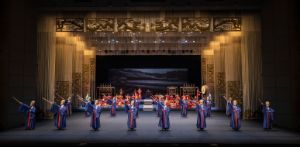
Jongmyo Jeryeak performance in National Gugak Center, Seoul
© National Gugak Center
This ritual music has a particular aesthetics. Its tempo is extremely slow and undergoes no dynamic climaxes, flowing along instead in a steady stream. It defies all extreme expressions of emotions like joy, grief or exuberance. This was intended to avoid all agitation. Lively rhythms are replaced by the most subtle dynamic nuances, micro-tonal pitch modifications and delicate tonal ornamentation.
The music is played by two orchestras: The upper terrace orchestra and the lower floor orchestra. The instrumentation follows the Chinese classification of “Eight Sounds” and gives a very specific sound to the orchestra. There are instruments that have existed for centuries but can only be heard in this music.
National Gugak Center
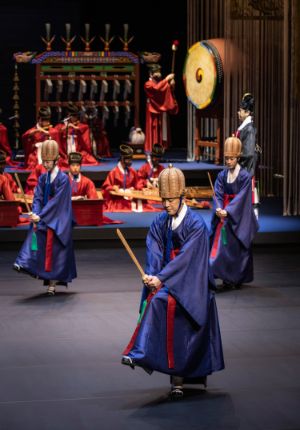
Jongmyo Jeryeak performance in National Gugak Center, Seoul
© National Gugak Center
The Court Music Orchestra faithfully carries out the tradition of court music which includes Jongmyo Jeryeak a designated UNESCO World Intangible Cultural Heritage. It held concerts with traditional and creative music works regularly during the1980s and 1990s. In the 2000s, the orchestra staged several performances in which the “original” form of the music-singing-dancing complex was restored and represented. In addition, the “complete” traditional music series was staged in this period. Since 2010, the orchestra has tried to widen the scope of activity. Through various artistic attempts, the orchestra enriched the tones of existing repertoires and staged new types of artworks based on changed performance formats. Currently, Yi Yeong is the music director of the Court Music Orchestra.
The Dance Theater has been making efforts to preserve and transmit various genres of traditional dance including Cheoyongmu (UNESCO Intangible Cultural Heritage), Court Dance (such as Seonyurak and Pogurak) and Folk dance. In addition, the company keeps trying to develop new creations that will be transmitted to next generations. In the 1990s, the efforts of restoration and representation of court dances had begun. Such efforts as well as the increase of new creations led to the productions of new performance as well as of artworks inspired by historical figures or Buddhist rituals in the 2000s. In the 2010s, a piece with a new interpretation of court dance of the Joseon Dynasty was performed. Currently, Park Sook Ja is the dance director of the Dance Theater.
The Folk Music Group and the Contemporary Gugak Orchestra complete the National Gugak Center’s performance groups.
The dance that belongs to this rite was already performed in Korea during the Goryeo Dynasty (918 – 1392). It is probably the most famous ritual dance in Korean history. The movements featured in the dances consist of around 50 simple movement patterns and are performed with great earnestness. Here too, all emotional reaction is avoided.
The Jongmyo Jery-ak is a visual and acoustic look back over 500 years of the Joseon Dynasty. The impressive vitality of the musical and artistic heritage in Korea can be experienced in a special concert version created by the National Gugak Center.
A Korean Ceremony for the Ancestors in the Musikfest Berlin 2022 Programme
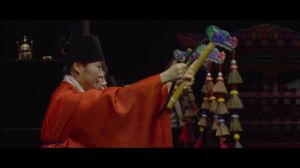
Jongmyojeryeak
© National Gugak Center Korea
Texts
Stefan Klöckner is professor of musicology/history of church music at Folkwang University of the Arts in Essen and director of the ensemble VOX WERDENSIS. For this digital guide, he wrote about Gregorian chant and the Vespro della Beata Vergine.
Frank Böhme,born in 1963, studied education and music in Berlin and Leipzig. Professor at the University for Music and Theatre Hamburg for Applied Music. 2009 – 2011 dean and director of the “Studium fundamentale”-programme at the HafenCity University Hamburg Of The Built Environment And Metropolitan Development (HCU). Since 2022 professor for theory and practice of world music.
Barbora Kabátková was interviewed by Daniel Frosch, music editor with Berliner Festspiele. It was first published in the Journal of Musikfest Berlin in August 2022.
